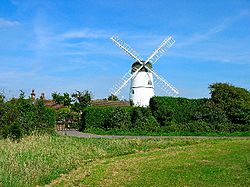Waterhall Mill, Patcham facts for kids
Quick facts for kids Westdene Windmill |
|
|---|---|

The mill in 2005
|
|
| Origin | |
| Mill name | Westdene Mill |
| Mill location | TQ 292 086 |
| Coordinates | 50°51′43″N 0°09′58″W / 50.862°N 0.166°W |
| Operator(s) | Private |
| Year built | 1885 |
| Information | |
| Purpose | Corn mill |
| Type | Tower mill |
| Storeys | Four storeys |
| No. of sails | Four sails |
| Type of sails | Spring Patent sails |
| Windshaft | cast iron |
| Winding | Fantail |
| Fantail blades | Five blades |
Waterhall Mill, also known as Westdene Windmill, is a special old windmill in Westdene, Sussex, England. It is a Grade II listed building, which means it's important and protected. This type of windmill is called a tower mill. Today, it has been changed into a home.
The Mill's Story
Waterhall Mill was built in 1885 by a person named James Holloway. He was a millwright, someone who designs and builds mills, from Shoreham-by-Sea. This mill was the very last windmill ever built in Sussex.
The mill worked for many years, grinding corn into flour, until 1924. During World War II, it had a different job. The Home Guard used it as a lookout spot to watch for danger.
In 1963, the windmill was turned into a house. Luckily, much of its original machinery was kept inside. The outside of the mill was also fixed up to look like it used to. New sails were put on in 1972. After a lightning strike in December 1990, the top part (called the cap) was partly rebuilt, and new sails were added again.
How the Mill Worked
Waterhall Mill is a four-storey brick tower mill. This means it has a tall, round brick base. It has a rounded top, called a domed cap.
The mill used a special part called a five-bladed fantail to turn the cap. This helped the sails face the wind. It had four large Spring Patent sails that caught the wind. These sails were attached to a strong cast iron rod called a windshaft.
Inside, the mill had an iron Brake Wheel. This wheel helped control the speed of the mill. The mill also had three pairs of millstones. These large, heavy stones would grind the corn into flour.
The tower of the mill is quite big. It is about 19 feet (5.79 m) wide at the bottom. At the top, where the cap sits, it is about 13 feet (3.96 m) wide. The whole mill stands about 40 feet (12.19 m) tall to the top of its main structure.

